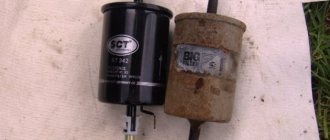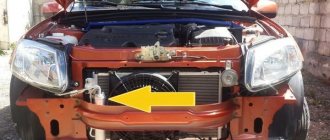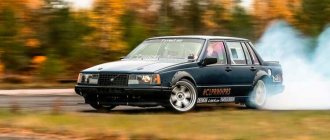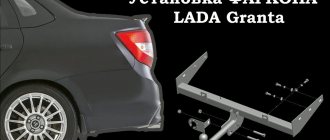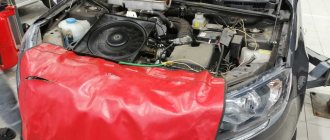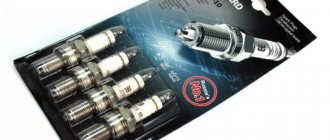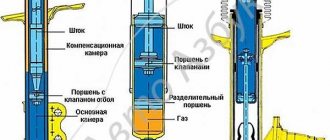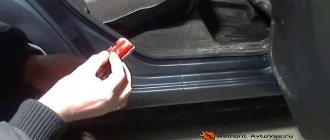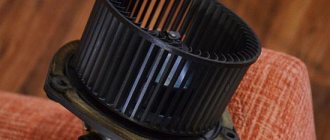Potential buyers and car owners are concerned with the question: does the Grant model have a galvanized body or not? The concern is easy to understand: the cost of the body is a significant part of the price of the budget car Lada Granta, galvanization protects the structure from the influence of adverse external factors.
Different sources provide conflicting information. Official representatives of the AvtoVAZ concern claim: the Lada Grant has a galvanized body, some sales dealers refute the statement.
How to care for an expensive car body, regardless of whether the body of the Lada Grant is galvanized or not?
Information from official representatives of AvtoVAZ
At the concern's factories, metal body elements are treated with a layer of galvanization. The low cost of the car does not allow covering the entire metal area; they protect the most vulnerable areas susceptible to corrosion:
• doors; • hind wings; • rear wheel niches; • luggage compartment lids; • body protective screen; • floor; • protective casing; • frame details; • rear wing groove.
The main vital structural elements are treated with a coating; the question can be removed whether the body of the Lada Grant is galvanized or not.
Which Lada models have a galvanized body?
It is unknown what percentage of parts are galvanized. Various figures periodically appear in the media, but they are not officially confirmed. The degree of galvanization of Lada cars from the media (list):
- VAZ 2110 - 30%;
- Lada 4×4 (Niva 2121 and 2131) - cataphoretic priming, no galvanized steel.
- Lada Kalina 1 - 52%;
- Lada Kalina 2 - everything is galvanized except the front and rear side members, roof and hood;
- Lada Priora - since August 2008, the body has been galvanized by 29%, and after 2009 by 100% (video);
- Lada Largus - photos of galvanized parts were posted by tourists who visited AvtoVAZ as part of excursions;
- Lada Vesta - for the first time, the outer layer of the body was galvanized (the roof of the sedan is not galvanized, the station wagon is completely galvanized), and the sills and bottom have anti-gravel protection;
- XRAY - only the roof of the external panels is not galvanized, but this is normal practice for the global automotive industry. When testing the corrosion resistance of the body, the XRAY roof passed the test better than the Vesta roof.
Information from the official website:
- Lada Granta sedan: 32% of the weight of body parts is made of galvanized steel. Moreover, 75% of galvanized metal is hot-dip galvanized steel with 2-sided coating. Strong and durable anti-gravel coating on the bottom. Hidden body cavities are treated with anticorrosive. The muffler is made of stainless steel.
- LADA Granta liftback uses galvanized steel (bottom, mudguards, sides), high-strength steel (power frame of the body). Polyester primer with increased chip resistance, black bumper skirt edging
- Lada XRAY: double-sided galvanization of external body panels. Anticorrosive underbody and hidden body cavities.
Factory galvanizing methods
Discussions about domestically produced cars do not subside. They argue about the Lada Granta, whether the body is galvanized, how the price corresponds to the quality, meanwhile the giant AvtoVAZ continues its strategy of improving the cars it produces and improving galvanization as well.
The factories use the following coating methods:
• thermal galvanizing is the most reliable;
• galvanization, when zinc is deposited from a solution on the surface of parts under the influence of electric current;
• coating with a primer with preliminary application of manganese, zinc and iron salts to the metal surface.
Car body stiffness table
| car model | Hardness, Nm/deg |
| Alfa Romeo 147 3d | 18800 |
| Alfa Romeo 147 5d | 16250 |
| Alfa Romeo 156 | 18800 |
| Alfa Romeo 159 | 31400 |
| Alfa Romeo 166 | 24400 |
| Alfa Romeo MiTo | 17650 |
| Aston Martin DB9 Convertible | 15500 |
| Aston Martin DB9 Coupe | 27000 |
| Aston Martin Vanquish | 28500 |
| Audi A2 | 11900 |
| Audi A8 D2 | 25000 |
| Audi A8 D3 | 36000 |
| Audi A8 D4 | 45000 |
| Audi R8 | 40000 |
| Audi TT Coupe mk1 | 19000 |
| Audi TT Roadster mk1 | 10000 |
| Audi TT Roadster mk2 | 22000 |
| Bentley Azure | 18000 |
| Bentley Continental Supersports | 24000 |
| Bentley Flying Spur mk2 | 36500 |
| BMW 7 series E65 | 31200 |
| BMW 7 series F01 | 37500 |
| BMW E34 | 17200 |
| BMW E36 Touring | 10900 |
| BMW E39 | 24000 |
| BMW E46 Convertible | 10500 |
| BMW E46 Coupe | 12500 |
| BMW E46 Sedan | 13000 |
| BMW E46 Wagon | 14000 |
| BMW E60 | 24000 |
| BMW E90 | 22500 |
| BMW F10 | 37500 |
| BMW F30 | 25000 |
| BMW X5 E53 | 23100 |
| BMW X5 E70 | 28000 |
| BMW Z3 mk1 | 5600 |
| BMW Z4 Coupe mk1 | 32000 |
| BMW Z4 Roadster mk1 | 14500 |
| BMW Z8 | 40000 |
| Bugatti EB110 | 19000 |
| Bugatti Veyron | 50000 |
| Chevrolet Corvette C5 | 9100 |
| Chrysler Crossfire | 20140 |
| Citroen Picasso mk1 | 17000 |
| Daewoo Lanos 3d 1997 | 10500 |
| Daewoo Nubira 1997 | 14500 |
| Dodge Durango mk1 | 6800 |
| Dodge Viper Coupe mk2 | 7600 |
| Ferrari 360 Spider | 8500 |
| Ferrari 575M Maranello | 14700 |
| Ferrari F50 | 34600 |
| Fiat Brava | 9100 |
| Fiat Bravo | 10600 |
| Fiat Punto 3d | 19700 |
| Fiat Tempra | 6700 |
| Ford Fiesta 3d 1995 | 6500 |
| Ford Focus 3d mk1 | 19600 |
| Ford Focus 5d mk1 | 17900 |
| Ford GT | 27100 |
| Ford GT40 MkI | 17000 |
| Ford Maverick 5d 1995 | 4400 |
| Ford Mustang 2003 | 16000 |
| Ford Mustang 2005 | 21000 |
| Ford Mustang Convertible (2003) | 4800 |
| Ford Mustang Convertible (2005) | 9500 |
| Jaguar XK mk2 | 16000 |
| Jaguar X-Type Estate | 16300 |
| Jaguar X-Type Sedan | 22000 |
| Koenigsegg Agera | 58000 |
| Koenigsegg Agera R | 65000 |
| Koenigsegg CC-8 | 28100 |
| Lamborghini Aventador | 35000 |
| Lamborghini Gallardo | 23000 |
| Lamborghini Murcielago | 20000 |
| Lancia Kappa Coupe | 27350 |
| Land Rover Freelander 2 | 28000 |
| Lexus LFA | 39130 |
| Lotus Elan | 7900 |
| Lotus Elise S2/Exige (2004) | 10500 |
| Lotus Esprit SE Turbo | 5850 |
| Maserati Quattroporte 2008 | 18000 |
| Mazda CX-5 | 27000 |
| Mazda CX-7 | 23700 |
| Mazda Rx-7 FD | 15000 |
| Mazda Rx-8 | 30000 |
| McLaren F1 | 13500 |
| Mercedes SL R230 | 16400 |
| Mercedes SL R231 | 19400 |
| Mercedes SLS Roadster | 18000 |
| Mercedes E-Class W212 | 29920 |
| Mercedes S-Class W221 | 27500 |
| Mercedes S-Class W222 | 40500 |
| Mini (2003) | 24500 |
| Nissan Micra 1995 | 4000 |
| Nissan Prairie 4×4 5d 1995 | 7500 |
| Nissan Sunny 3d 1995 | 8200 |
| Opel Astra 3d 1998 | 10500 |
| Opel Astra 4d 1998 | 11900 |
| Opel Astra 5d 1998 | 11700 |
| Opel Combo 1999 | 18500 |
| Opel Corsa 3d 1995 | 6500 |
| Opel Corsa 3d 1999 | 8000 |
| Opel Omega 1999 | 13000 |
| Opel Vectra 4d 1999 | 8800 |
| Pagani Zonda C12 S | 26300 |
| Pagani Zonda F | 27000 |
| Pagani Zonda Roadster | 18000 |
| Peugeot 206 CC | 8000 |
| Peugeot 407 | 22700 |
| Porsche 911 Carrera S 991 | 30400 |
| Porsche 911 Turbo 993 | 13500 |
| Porsche 911 Turbo 996 | 27000 |
| Porsche 911 Turbo 996 Convertible | 11600 |
| Porsche 911 Turbo 997 | 34000 |
| Porsche 959 | 12900 |
| Porsche Carrera GT | 26000 |
| Porsche Cayman 981 | 42000 |
| Porsche Panamera | 25000 |
| Range Rover mk3 | 32500 |
| Renault Sport Spider | 10000 |
| Renault Twingo 1995 | 14200 |
| Rolls-Royce Phantom | 40500 |
| Saab 9-3 Cabriolet mk2 | 11500 |
| Saab 9-3 Sedan mk2 | 22000 |
| Saab 9-3 Sportcombi mk2 | 21000 |
| Seat Leon 2005 | 23800 |
| Toyota Corolla 3d 1995 | 10500 |
| Toyota Prius 2001 | 22700 |
| Toyota Starlet 5d 1995 | 7600 |
| Volkswagen Fox 2007 | 17900 |
| Volvo S60 mk1 | 20000 |
| Volvo S80 mk1 | 18600 |
| VW Golf V GTI | 25000 |
| VW Passat B6 | 32400 |
| VW Phaeton | 37000 |
| VAZ-1111E Oka | 7000 |
| VAZ-21043 | 6300 |
| VAZ-2105 | 7300 |
| VAZ-2106 | 6500 |
| VAZ-2107 | 7200 |
| VAZ-21083 | 8200 |
| VAZ-21093 | 6800 |
| VAZ-21099 | 5500 |
| VAZ-2110 | 8000 |
| VAZ-21102 | 8400 |
| VAZ-21106 | 12200 |
| VAZ-21106 (racing) | 51800 |
| VAZ-21108 Premier | 10500 |
| VAZ-21109 Consul | 14300 |
| VAZ-2111 | 7400 |
| VAZ-2112 | 8100 |
| VAZ-2115 | 5500 |
| VAZ-2120 Nadezhda | 10000 |
| VAZ-21213 Niva | 8900 |
| VAZ-2123 Chevy Niva | 12000 |
| VAZ-2131 Niva | 7400 |
| GAZ-M20 Pobeda | 4600 |
| MZMA-400 Moskvich | 2500 |
Of course, torsional rigidity of the body is one of the most important indicators of a modern car. Let's hope that over time, our engineers will come up with more efficient designs and improve the design so that domestic cars occupy the top positions in the ranking of the best cars in the world for this indicator.
- Absolutely legal (Article 12.2);
- Hides from photo and video recording;
- Suitable for all cars;
- Works through the cigarette lighter connector;
- Does not cause interference to radios and cell phones.
Torsional rigidity of the body or LC/c is a value that characterizes the strength characteristics of the automobile frame, its durability and safety. This value has a strong influence on the car’s handling. That is why the world's famous supercars, equipped with carbon fiber and soft lightweight body panels, are distinguished by the highest values of this very parameter. Let's look at the LCD performance of well-known domestic models and compare them with the performance of foreign cars.
Debunking myths
1. Does a galvanized body not rust?
Even if, when buying a car, when asked whether Granta is galvanized or not, the dealer gives you a positive answer, it’s too early to calm down. Due to the very thin coating layer and its partial nature, rapid reduction of the galvanizing layer is guaranteed.
Without additional treatment, the body will still rust.
2. Does a new car require additional body work?
Factory protection is imperfect. Even a new car requires preventive anti-corrosion treatment. During operation, the body coating is subjected to strong mechanical stress, causing cracking of the coating, moisture entering the cavities and corrosion of body elements.
3. Does the aluminum body not rust?
In fact, the entire body cannot be made of stainless aluminum; steel is also used, it is susceptible to corrosion. Aluminum oxidizes over time and turns into powder.
4. Will the factory rust protection last for many years?
The rate of metal corrosion largely depends on operating conditions and climatic conditions. A metal layer 0.6 mm thick can rust through in six years! The body needs to be treated.
5. Mud flaps and fender liners, plastic covers are useless?
Not true. The equipment reduces the abrasive effect of dirt and sand on the body.
Installation of elements is carried out using self-tapping screws, external joints are treated with anti-corrosion coatings. Mud flaps are attached with maximum adherence to the wings and body.
Regardless of whether the Granta body is galvanized or not, preventive treatment of the body must be performed.
Features of anti-corrosion treatment
Regardless of whether the body is galvanized or not, certain rules must be followed. The optimal time for implementing anti-corrosion measures in LADA Granta is a dry and warm period. It is recommended to carry out the work annually or once every two years (as appropriate).
If the procedure involves treating external and unprotected body surfaces, then bitumen-based mastic is perfect. The process is not complicated, so it can be easily done at home. There are mastics both drying and lacking this quality. The latter options are characterized by sufficient elasticity, but are not resistant to mechanical factors. Application of mastic involves achieving a layer thickness of 0.4 mm, which allows for maximum noise insulation effect.
To effectively treat hard-to-reach and hidden cavities on the body, it is recommended to use substances based on an oil structure. This allows you to effectively fill pores and cracks. Elastic mastics are also excellent, one of the advantages of which is the ability to effectively displace moisture. These processing agents have a paraffin or wax structure.
Lada models with galvanized body
There is no exact information about how many parts are galvanized, and AvtoVAZ does not disclose them. Various indicators are mentioned, but there is no official confirmation of them. According to media reports, Lada cars have the following degree of galvanization:
- VAZ-2110: 30%;
- Niva 2131/2121, Lada 4x4: no galvanized steel, cataphoretic priming;
- Kalina (first generation): 52%;
- Kalina (second generation): fully galvanized, except for the hood, roof, rear/front side members;
- Priora: models from 08.2008 – galvanized 29%, from 2009 – 100%;
- Largus: there are galvanized parts, which ones are unknown;
- Vesta: the outer body layer is completely galvanized (sedan - with a non-galvanized roof, station wagon - fully galvanized), the bottom and sills are with anti-gravel protection;
- Xray: external body elements are completely galvanized, with the exception of the roof.
And now what is officially known:
- Granta (sedan): galvanized steel makes up 32% of the weight of all body parts. The share of hot-dip galvanized steel with double-sided coating from galvanized metal is 75%. The bottom is treated with a durable and strong anti-gravel coating, in hidden cavities there is anti-corrosive coating;
- Granta (liftback): galvanized steel in the sidewalls, mudguards and bottom, high-strength steel in the load-bearing body frame;
- Xray: external body panels are double-sided galvanized; anti-corrosive coating is applied in hidden cavities and on the bottom.
What is body galvanization and why is it needed?
As a rule, after 4 years of operation of the vehicle, corrosion appears on the body, which causes the iron to rot. The most commonly affected elements are sills, fenders and underbody. In order to prevent corrosion, increase resistance to mechanical stress and adverse environmental factors, vehicles are galvanized. This is a procedure during which the body is subjected to special treatment. When damage occurs, corrosion only destroys the zinc.
Galvanization: has the body been processed at the proper level?
ATTENTION! A completely simple way to reduce fuel consumption has been found! Don't believe me? An auto mechanic with 15 years of experience also didn’t believe it until he tried it. And now he saves 35,000 rubles a year on gasoline! Read more"
Today, at the Togliatti plant, the processing of the body and its metal parts involves a standard layer of galvanization. True, not the entire area of the car is subjected to this process, but only the most vulnerable areas of the body, such as the bottom, etc. First of all, these areas are located close to the road surface, thereby being damaged quite often: chips, scratches and damage to the integrity of the surface paintwork Such places of the body are a common phenomenon.
Note. What does the galvanizing layer do in this case? It effectively protects the body frame from rusting, preventing the process from further progressing rapidly in areas of chips and scratches.
On the one hand, a layer of galvanization, of course, cannot completely protect the metal from corrosion. On the other hand, if it were not there, the elements would begin to rust in short periods of time, after some minor accident or the car falling off the jack.
There is a lot of controversy regarding galvanizing. In particular, the question concerns the following: is the body of the Lada Granta sufficiently galvanized, if we keep in mind the percentage ratio. Here is what I would like to say about this:
- Lada Granta is considered a budget car, which automatically excludes full processing;
- It is precisely because the Granta is a budget car that it has fewer body elements designed to work in harsh conditions.
On the other hand, all “vitally” important body elements of the car are, of course, coated at the factory with a layer of galvanization. This happens in the press shop, where zinc is applied to the steel sheet on both sides.
Is it worth carrying out additional anti-corrosion treatment on the Lada Granta? Car owners often ask on forums. The manufacturer does not advise doing this, hinting that he has foreseen everything himself. On the other hand, no matter what guarantee against corrosion AvtoVAZ gives for the first 6 years of car operation, we were not born yesterday, and we understand that the manufacturer’s guarantee is one thing, but the real situation is completely different.
Here are the areas of the domestic car that are most at risk:
- Rear wheel wells and fenders;
- Trunk sides;
- Bottom;
- Door pillars and trim;
- Protective components, etc.
Some car owners claim that some Grants do not have galvanization at all, which explains the low cost of the car. Is it really? AvtoVAZ categorically denies this information, claiming the opposite. Yes, galvanizing does not occur in full, but the strategy of protecting the most important areas of the body is carried out without fail.
In general, quite a lot of myths about domestic car models have been appearing lately. Some people, supposedly cool specialists, come to various topics and start spouting all sorts of nonsense that AvtoVAZ products will soon crumble before our eyes. It is noteworthy that most of the “false experts” are personally unfamiliar with modern versions, but judge products based on old models from the 90s.
The modern corrosion resistance of VAZ models, even the most budget ones, has improved significantly. Modern paint booths, “smart” robots, universal stamping shops with the appropriate equipment - all this is available and working at AvtoVAZ today. And the result does not take long to wait: body gaps have decreased, parts have been fitted perfectly. In addition, all surfaces of the body undergo appropriate treatment, since the entire body is immersed in a bath of primer. If earlier it was difficult to imagine, today no one doubts the power of a robot that can easily lift a heavy body as a whole and dip it properly into the composition.
